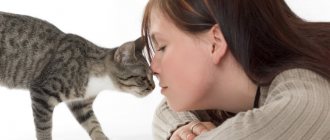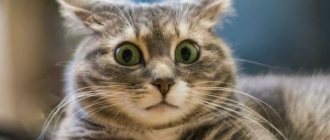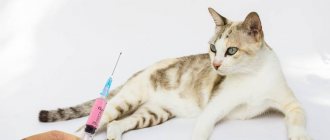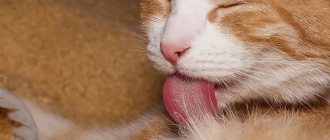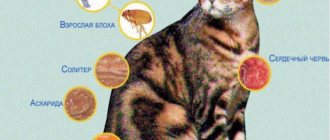- home
- Cats
- What is the benefit to humans from the purring of cats?
Cat owners will confirm that there is nothing better than cuddling with your pet, stroking it behind the ears and listening to a contented purr. But this cute sound not only shows us that the cat is happy, but can also bring real benefits to humans.
Important! Cats purr at a specific frequency that is believed to have healing benefits for humans - from heart health to strong, strong bones.
Purring is a way for fluffies to communicate, through which they show us the full range of their emotions. Depending on the breed, cats may purr in different ways. But, basically, the range of their purring is 18-20 Hz. So, how is it good for human health?
Benefit #1: Reduces Stress Levels
The feeling of satisfaction and relaxation when your beloved furry is nestled on your chest or lap is by no means a placebo effect. The frequency of a cat's purr falls into a very "therapeutic" sound range that relaxes the nerves and makes you feel more comfortable.
So the next time you're feeling stressed, try sitting down with your cat on the couch and see if its vibrations are working for you.
A reason to purr
Cats do not always purr, but only in special cases:
– after games and communication with the owner, when the animal is about to rest; – the mother cat demonstrates to the kittens that they are safe and need not be afraid; – when an owner strokes his pet, this indicates great love and devotion; – when he hears the aroma of his favorite food; – the male cat purrs in the company of a weaker opponent, showing him that there will be no fight; – during illness, when the animal wants to bring its circulatory process back to normal; – when you’re scared, to calm yourself down and set yourself at peace; – sometimes cats purr before they die, perhaps this is how they say goodbye to their owner.
Benefit #2: Lowers Blood Pressure
The "magic" frequency of cats' purring is said to lower blood pressure. There are no definitive research results to support this, but there are a couple of logical explanations.
One of them is that purring reduces stress levels, thereby affecting blood pressure. Therefore, the higher your resistance to stress, the more stable your blood pressure will be and the healthier your body will be overall.
Cats heal people with their purring
Scientists from the Institute of Animal Communication in North Carolina (USA) have come to a clear conclusion - a cat should be in every home. She is a healer.
[advert]
For decades, scientists have studied cat voices. As a result of many experiments, it was established that a cat’s purring is not just an animal’s conversation, it is a powerful healing agent that allows it to quickly restore its strength and also heal wounds. It is purring that increases their vitality, and also has a beneficial effect on the human body, helping it fight various diseases.
➤ It has been proven that purring is a set of vibrations of certain frequencies that affect the activation of the protective forces of the human body. Surprisingly, but true, a cat’s purring helps strengthen (by 20%) and heal broken bones. It's all about the unique range of its “cooing” - from 27 to 44 hertz. ➤ Also, a cat’s purring has a beneficial effect on the human nervous system and psyche. ➤ In addition, it is with sounds emanating in this range that a person’s cerebral circulation improves, blood pressure normalizes, heart rate stabilizes, and immunity against colds increases. ➤ Cats not only relieve stress and help with depression, but also reduce withdrawal symptoms in drug addicts and alcoholics. ➤ Among other things, kitty helps against colitis, flatulence, gastritis, stomach ulcers, flu, insomnia, osteochondrosis, even frigidity and impotence. ➤ Cat owners live on average 4 to 5 years longer than cat owners. ➤ However, it should be noted that this applies to lovers of almost all animals. ➤ When the owner strokes his pet, bioenergetic contact occurs between them, positive impulses are sent to his central nervous system - his mood rises. ➤ Thanks to the cat’s habit of massaging with its claws, a person’s reflexogenic zones are irritated - the claws work in the same way as instruments during an acupuncture session. ➤ Again, it has been proven that cats living in the house have a beneficial effect on the health of children. Thanks to their presence in the child's body, antibodies are produced that help prevent childhood asthma. ➤ But for many allergy sufferers, animal fur is a powerful irritant; here you need to consult a doctor who will tell you how possible it is to communicate with cats. Convinced dog lovers can also express their reluctance to have a dog.
WHITE, BLACK, RED, BLUE... “Now cat therapy in the USA and especially in the UK is experiencing a real boom,” says artistic director of the “Cat House” theater, People’s Artist of the RSFSR Yuri Kuklachev. — The cat unmistakably guesses the owner’s sore spot and always lies down exactly on it. Moreover, cats of different breeds and colors have their own specialization.
Whites are considered universal. By the way, in England it was white murks that were recognized as medicinal. As experiments have shown, white cats are useful for lethargic people, they feed them with energy. Blacks, on the contrary, rid their owners of negative energy. They are well suited for temperamental, hot-tempered people. Also, these animals cope better than others with the functions of a protector and will warn of danger in time. Redheads cheer up their owners. Grays have equally the qualities of black and white cats. Persian cat. Low-active, apathetic cat, loves a calm environment. She can practice healing for a long time, but at the same time she takes away negative energy from the owner in small quantities. The Persian cat relieves a person from irritability and nervous breakdowns. They are considered excellent neurologists and can cure the owner of depression, insomnia and irritability. Angora cat. Affectionate, kind and non-aggressive. He is considered the best diagnostician and always accurately guesses the sore spot. She is capable of treating for a long time and sometimes does not leave her owner for hours. Sphinx . Peace-loving cat. The Sphynx is able to absorb a lot of negative energy at once and is considered one of the most talented healers among cats. perfectly treats diseases of the kidneys, stomach and intestines. Siamese cats can cure colds and infectious diseases. They have the gift of killing pathogenic microbes, which is still inexplicable to scientists. Russian blue. Affectionate, active, independent, but requires a lot of attention. It takes little energy, but is an excellent diagnostician. It should be noted that simple yard cats cope with human ailments just as well as their purebred counterparts. NOTE : It is well established that cats have a better healing effect than cats. Moreover, the former have a positive effect on people with diseases of the nervous system and internal organs, and the latter on those who suffer from osteochondrosis, radiculitis and arthrosis.
Benefit #4: Heals... fractures
Research has shown that cats' purring can also improve bone strength. And this facilitates their healing after a fracture or crack.
The best frequencies for increasing bone strength are 25-50 Hz. And since most domestic cats purr in the range of around 20 Hz, it definitely promotes healing and strong bones.
How is it useful?
The benefits of purring and the ability of cats to heal have been known to people for a long time. Recent research at the intersection of bioacoustics and medicine has only confirmed empirical guesses. The animal treats the following diseases:
- nervous disorders;
- hypertension;
- arrhythmia;
- bone fractures;
- stomach diseases;
- obesity;
- gynecological diseases;
- alcoholism and drug addiction;
- edema of various etiologies.
Constant communication between a child and a pet prevents the occurrence of allergic reactions in the dermis.
For some people, cat fur is an allergen. However, American scientists, having conducted a number of studies, have proven that regular communication between a child from the age of 2 and a pet prevents the occurrence of allergic skin reactions and asthma. The habit of cats to massage the owner’s skin with their claws is a useful massage session in combination with acupuncture. Simple communication with an animal is healing for any age group, especially for the elderly, as it prolongs their life.
Benefit #6: Relaxes and heals sore muscles
The same level of vibration that has a healing effect on the bones is very beneficial for the soft tissues of our body.
Therefore, after a busy day at work or in cases of inflammation and muscle strain, try treating yourself with the help of your beloved pet. Just lie down next to him and scratch him behind the ear. In response, you will hear a purr that will relax and heal your tissues.
Interesting! It is believed that this benefit helps cats remain strong and resilient, even if they are lying on the sofa or windowsill 90% of the time.
How do animals purr?
The vocal cords are equipped with a group of muscles located nearby in the larynx. They allow cats to make characteristic sounds when inhaling and exhaling. The work of these muscles is controlled by brain impulses. Cat purring is an ability unique to felines and no one else in the natural world. Close relatives - lions and leopards - express their pleasure more often with other sounds. It's a snort, a low growl.
When do they purr?
There are many situations that cause a cat to reproduce a characteristic purr. These include:
- A newly born blind and deaf kitten finds the nipple by the purring of its mother, the vibrations of which it feels with its body. During feeding, the cat becomes silent.
- During the period of estrus, the animal calls its mating partner with characteristic sounds of a different tonality, but reproduced according to the same principle - with the help of additional muscles in the larynx.
- Comfortable communication between a cat and its owner, friendly individuals, and its own litter is always accompanied by purring.
- Satisfaction with life after a hearty meal is also a reason to purr.
The sounds made by animals, including the purring of cats, are studied by bioacoustics.
There is an opinion that a cat purrs not only when it is happy, but also to relieve its own stress.
Scientists have suggested that cats purring is not always a sign of satisfaction or pleasure. In addition to its utilitarian purpose in matters of feeding offspring and attracting a mate, purring is used by cats to relieve their own stress. There is a known case where a cat was taken from home to another place located 3 km away. The animal did not like the situation and ran away. Having found its home only 10 days later, the cat walked around the house and purred all day. It has also been observed that cats purr when they are sick. Apparently, these sounds also heal the animal itself.
Come on in, apply yourself!
How does a feline therapy session differ from home contact with cats? “In therapy, we can purposefully try to establish contact between the cat and the person. Invite the animal to lie down in certain places and massage specific parts of the body,” explains Nika Mogilevskaya.
On average, a session lasts 30-45 minutes. The patient needs to take a comfortable position and tune in to a calm mood, because cats sense the human condition. You can meditate a little or just breathe deeply. “Feel your body - especially those places where there is discomfort or pain,” explains the pet therapist. But holding a cat by force, offering it treats, or controlling it in any other way is not recommended.
Nika Mogilevskaya warns that organizing a feline therapy session is not easy: “The cat walks on its own and acts only of its own free will. A pre-agreed session may not take place due to the fact that the cat fell asleep or did not want to communicate.”
The solution is simple: if you want to try therapy with a furry therapist, look for a therapist who owns a cat. Perhaps sooner or later you will experience the delights of feline therapy. Or just have a good time in the company of a beautiful, willful and mysterious animal.
Why do cats purr?
It is a common belief that cats purr to show their happiness, but they also purr when they are scared, seriously injured, giving birth and even dying. Many research institutes are delving into the question of why some cats spend their energy purring alone, as well as in the company of their owners.
Purring in cats has been preserved for a long period of time and has not disappeared with evolution. There must be some kind of survival mechanism for cats in purring. Additionally, there must be a good reason for expending energy to produce a purr when the pet's owner is stressed or ill. However, scientists still cannot answer exactly why cats purr.
And the beast is not real!
In feline therapy, not only contact, but also non-contact methods of work are used.
After all, sometimes for various reasons (for example, due to health restrictions) we cannot touch an animal or caress it. “The simplest non-contact method of feline therapy is to simply watch the cat. This sight has a calming effect on us,” says Nika Mogilevskaya. And if there is no cat, but you really want to communicate with it, pet therapists offer a substitute toy. By using our imagination, we can imagine that we are petting a cat and even “hear” it purring. We can depict the animal ourselves - and this is also a method used by feline and pet therapists.
“We invite clients to take different poses that imitate the poses of the beast. When we imitate the pose of a kind cat - we get on all fours, arch our lower back and smoothly raise our head up - we become both kinder and more cheerful. If we are in a bad mood, we can pretend to be an angry cat: also stand on four supports, but arch our back upward, as if we are very angry. If we also express our anger by snorting, we will quickly get rid of negative emotions,” explains Nika Mogilevskaya.

